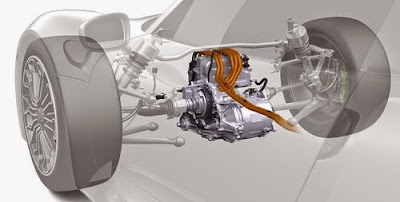Porsche has awarded GKN Driveline “technology partner” status for its development of a high-performance eAxle for the 918 Spyder, an advanced plug-in hybrid supercar. GKN Driveline’s eAxle module supports full-electric mode, all-wheel drive and provides a boost function.
Porsche Powertrain manager Christian Hauck said: “Realising our vision for a super sports car capable of setting a record lap time of the Nurburgring and of achieving fuel efficiency of three litres per 100 km placed huge demands on our engineers and suppliers.
“GKN Driveline’s role in the development programme and its innovative eAxle module has earned the company Porsche Technology Partner status.”
GKN Driveline’s president of engineering Peter Moelgg added: “Being selected as Porsche’s Technology Partner on the 918 Spyder programme was the perfect opportunity for our global e-drive team to demonstrate how putting the right technology on board can improve both fuel efficiency and dynamic performance.
“The award cements GKN Driveline’s position as the industry leader in e-drive systems. Our eAxle technology continues to evolve and we expect many more high-performance vehicles to adopt similar driveline concepts in the coming years.”
The eAxle that supplements the 918 Spyder’s hybridized 4.6-litre V8 is a development of the company’s eAxle drive. The module has maximum power of 95kW and can deliver up to 1500Nm of torque to the front wheels via a fixed gear ratio.
A specially developed compact differential engages the torque, giving the 918 Spyder optimum power distribution at all times. The differential also disengages the module to minimise drag losses and maximise efficiency. At speeds above 265km/h (164mph), a clutch isolates the electric motor to prevent it from over-spinning.
A key target for the 918 Spyder was to have the lowest possible centre of gravity and ground clearance. To achieve this required an original engineering solution: GKN Driveline positioned the output overhead, using an lubrication concept to manage the oil flow.
The oil reservoir is positioned above, not below, the geartrain. Oil is gravity-fed down onto the bearings and gears until it reaches the high-speed input at the bottom where it is then circulated back to the oil reservoir at the top.
This design minimises the amount of oil on the input shaft, keeping churning losses to a minimum. To ensure the critical areas remain lubricated even in disconnect mode, the motor is driven for brief, intermittent intervals to maintain a constant flow of oil.
The Porsche 918 Spyder’s tight packaging also means there is almost no air flow around the transmission and so water cooling was needed to manage the heat generated by the module’s high power density.
“To meet the 918 Spyder’s challenging targets for weight, power density, NVH and durability, we used state-of-the-art simulation and analysis tools developed in-house to optimise the geartrain,” said Moelgg. “An eAxle that meets both Porsche’s requirements and the demands of the Nurburgring can deliver in any situation.”


